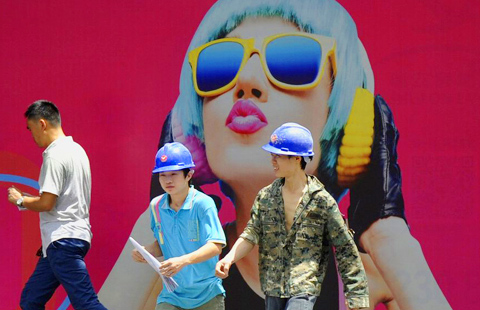City goes bespoke, others follow suit
Updated: 2015-06-19 11:31
By Yu Ran in Shanghai(China Daily USA)
|
||||||||
Shanghai men, known for being well-dressed and suave, started the trend of wearing tailor-made Western suits as early as a century ago.
The establishment of Shanghai as a treaty port in 1843 attracted large numbers of merchants from overseas who started businesses in the city. They wore formal suits while the local Chinese were still wearing long robes.
Tailor shops emerged in Shanghai around the 1850s - most of the suit-makers of that time being British or Jewish, brought here by Western merchants. They passed their craft on to apprentices who came from Ningbo and Fenghua in Zhejiang province, and these Chinese tailors became famous for their skills.
"Most of those tailors learned how to make suits by mending the worn-out outfits of foreign merchants," said Bian Xiangyang, a professor who specializes in apparel studies at Shanghai Donghua University.
In 1896, the first homegrown Chinese tailor shop, Hechang, opened on North Sichuan Road in Shanghai.
More shops run by Zhejiang tailors soon followed. Bian adds that another wave of local tailors started business in the following century, led by Baromon, a well-known Shanghai suit brand.
In the early days, apart from foreigners, only middle-class office workers employed by foreign firms and those who had been educated abroad, wore suits in the city.
"Chinese suits were made along the lines of the traditional European suits with jacket, vest and trousers, but were nipped in at the waist and shoulders to fit the slender figures of the locals," Bian said.
From the 1920s to 1940s, the suit became unofficial but compulsory wear for office workers in Shanghai, and even the lowest-level clerk would have two or three suits to maintain their status and image.
"I remember my grandfather telling me that every man walking down the streets in old Shanghai wore formal suits, even shoeshine boys," said Meng Jia, a men's clothes designer in Shanghai.
In order to stand out in society, the wealthy and the famous had their suits made in British, French, and Italian shops with expensive imported textiles, while most suits for city office workers were made by local tailors at much cheaper prices.
"The rich kept up their elegant images with detailed accessories to go with suits. There were diamond-studded cuff links, silk pocket squares and hats," Bian said.
"Unlike the fashion variations for qipao, the traditional women's dress, men's suits changed only slightly in style but men still managed to dress differently each season. For instance, they wore white suits in summer and darker ones in winter."
Meng added that old Shanghai-style tailor-made suits closely followed Western fashion, and local newspapers and magazines published what was most popular in Europe at the time.
By the late 1990s, tailor-made suits slowly faded out as a more casual style became global, relegating the suit to formal occasions.
"Men's suits have turned from tailor-made to factory produced, while the tradition of wearing suits is also disappearing as more people adopt T-shirts and jeans," Bian said.
yuran@chinadaily.com.cn
Most Viewed
Editor's Picks

|

|

|

|

|

|
Today's Top News
More than 'greet' and 'meet'
Obama suggests more gun control after shooting
Talks seen as prelude to visit by President Xi to US in September
The most costly cities for expats
House passes fast-track trade bill
Gunman kills nine people in South Carolina church shooting
US House moves to revive Obama's Pacific trade pact
Hong Kong lawmakers reject election reform proposal
US Weekly

|

|














